
The Mellerud rabbit is a Swedish variety of rabbit of medium size that comes in albino or black with white markings. The Mellerud rabbit has official landrace status in Sweden and is considered a critically endangered variety.

The Mellerud rabbit is a Swedish variety of rabbit of medium size that comes in albino or black with white markings. The Mellerud rabbit has official landrace status in Sweden and is considered a critically endangered variety.
The Mellerud rabbit shares part of its history with the better-known Gotland rabbit. Both landraces originated from old lines of farm rabbits that were once common all over Sweden. These rabbits were referred to as bondkaniner ('farm-rabbits') in as early as 1881 [1] and were kept mainly for their meat and pelts. In the 1900s farm rabbits disappeared from most parts of the country and were largely believed to be extinct.
In the late 1990s, a few rabbits of the old farm type were discovered in the care of an older woman, referred to as "Edith i Sjöskogen", living in Mellerud. She has kept rabbits since at least 1937, though the line was believed to be older still. The only known outcrossing to another population had been done in 1968, when two black and white rabbits, one buck and one doe, were added to the group. The population had earlier consisted of 15-20 animals on average, decreasing to lower numbers in recent years. A total of 7 animals were acquired from Edith in the early 2000s, providing the foundation animals for a breeding project to preserve the line. The Mellerud rabbit received official landrace status by Jordbruksverket in 2011. [2]
Föreningen Gotlandskaninen ('Gotland Rabbit Society') is responsible for the preservation work of the Mellerud rabbit along with the Gotland rabbit. Registered rabbits are maintained in an official gene bank registry. As of 2013, approximately 160 registered Mellerud rabbits are registered with the Society and breeders aim to produce a higher number of animals to ensure high genetic diversity. [2]
The Mellerud rabbit is similar to the Gotland rabbit in terms of conformation. It is a medium-sized rabbit with an adult weight of 3–3.5 kg (6.6-7.7 lbs). The body of the doe is relatively elongated with a fine head while the buck is usually somewhat more compact with a rounder head and thicker muzzle. There is no weight difference between the sexes. The ears are of medium length and relatively thin, pointed rather than rounded. The eyes are somewhat large with an alert expression. The eyes are brown, blue or a mixture of the two.
The coat is short and fine. The colour is either albino or black with white spotting, referred to as Dutch markings. Because breeders have never strived to standardise the markings in the variety, there is a higher degree of variation in the white markings than in most traditional show breeds. Most Melleruds exhibit white muzzles, blazes to varying degrees, white front of chest and white frontpaws. The white may also extend to and include the sides of the face, the shoulders, the back and/or the hind legs. [3]
The temperament of the Mellered rabbit is described as lively and curious. The Mellerud is often considered to be somewhat calmer than the Gotland rabbit, and also tends to produce somewhat smaller litters on average. The kits grow relatively slowly compared to modern production breeds, but in return require less feed. The landrace is considered hardy and few genetic defects are known. [2]
Mellerud rabbits are generally hardy and well adapted to living outdoors year round, provided they are protected against drafts and harsh sunlight. [4]
Mellerud rabbit breeders strive to produce animals that can consist on natural types of feed, mainly a good quality hay, which may be replaced with fresh grass and other non-toxic plants during summertime. Traditional rabbit pellets may be too high in calories for landrace rabbits and should be viewed as an occasional treat or fed in only small quantities, rather than a staple. It is important that the rabbit always has access to fresh water. [4]
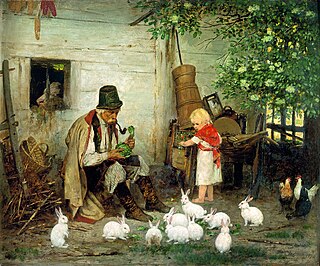
Cuniculture is the agricultural practice of breeding and raising domestic rabbits as livestock for their meat, fur, or wool. Cuniculture is also employed by rabbit fanciers and hobbyists in the development and betterment of rabbit breeds and the exhibition of those efforts. Scientists practice cuniculture in the use and management of rabbits as model organisms in research. Cuniculture has been practiced all over the world since at least the 5th century.

The Angora rabbit, one of the most ancient groups of domestic rabbit breeds, which is bred for the long fibers of its coat, known as Angora wool. They are gathered by shearing, combing or plucking. Because rabbits do not possess the same allergy-causing qualities as many other animals, their wool is an important alternative. There are at least 11 distinct breeds of Angora rabbit, four of which are currently recognized by the American Rabbit Breeders Association (ARBA): the English Angora, the French Angora, the Giant Angora and the Satin Angora. Other unrecognized breeds include the German Angora, the Finnish Angora, the Chinese Angora, the Japanese Angora, the Korean Angora, the Russian Angora, the St Lucian Angora and the Swiss Angora.

The American Rabbit is a breed of rabbit, recognized by the American Rabbit Breeders Association (ARBA) in 1917. According to the ARBA Standard of Perfection, American rabbits have a mandolin body shape. It has also been noted for a docile temperament and good mothering abilities. As with all domestic rabbits, the American breed is of the species Oryctolagus cuniculus, the European wild rabbit.
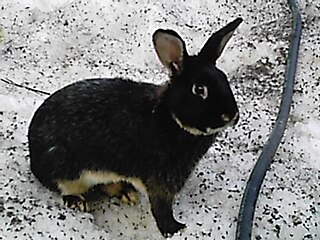
The Silver Marten is a breed of domestic rabbit. Although they are raised to compete in pet shows and agricultural shows, they are also regarded as "loveable and charming" pets.

The Gotland, also called the Gotland Pelt, is a breed of domestic sheep named for the Swedish island of Gotland. A breed of Northern European short-tailed sheep, they are thought to be the product of crossbreeding between the native landrace of the island — called the Gute — with Karakuls and Romanovs during the 1920s and 1930s.

The Checkered Giant, known as Géant Papillon in French, is a breed of domestic rabbit that originated in France. One of the largest rabbit breeds, the Checkered Giant is recognized by the American Rabbit Breeders Association (ARBA). The Checkered Giant is one of the minority of rabbit breeds with specific coat markings. The markings defined in the breed standard of the Checkered Giant differ somewhat from those in the breed standard of the Giant Papillon. For ARBA show purposes, a mature Checkered Giant buck must weigh a minimum of 11 pounds (5.0 kg), and a mature doe must weigh a minimum of 12 pounds (5.4 kg). ARBA does not specify a maximum weight for Checkered Giants.
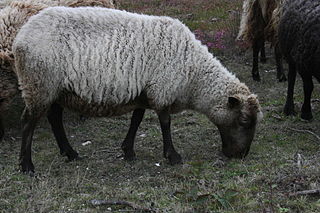
The Northern European short-tailed sheep are a group of traditional sheep breeds or types found in Northern Europe, mainly in the British Isles, Scandinavia, Iceland, Greenland, and the area around the Baltic. They are thought to be derived from the first sheep brought to Europe by early farmers. They are hardy sheep, adapted to harsh environments, but they are small and have been replaced in most areas with later types of larger, long-tailed sheep.
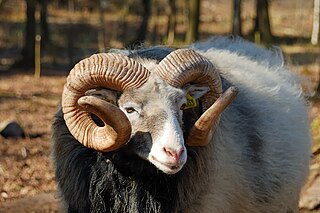
The Gute is a landrace-based breed of domestic sheep native to the Swedish island of Gotland. The Gute is the most primitive breed native to Sweden, and is one of the Northern European short-tailed sheep. The modern Gotland breed is its direct descendant. Unlike the Gotland, the Gute is horned in both rams and ewes, and has a fleece that appears in a wider variety of colors and patterns, which may be shed in the summer. This breed is raised primarily for genetic conservation.
Plush Lop is a breed of domestic rabbit with two varieties: Miniature and Standard. There is also a Canadian Plush Lop breed in development. Similar in appearance, the Velveteen Lop breed is also in development. Miniature Plush Lops were the first to be developed. Devie D'anniballe began creating this breed in 1995 in the United States. She succeeded in developing them by combining the previously existing breeds of Holland Lop, Mini Rex, and Mini Lop. Her aim was to create the perfect pet by retaining the good qualities of these breeds, while "breeding out" all the problems existing in these breeds.
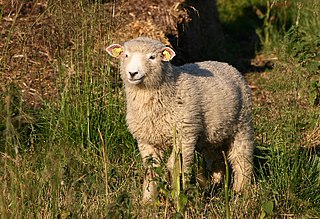
The Danish Landrace is a breed of sheep endemic to Jutland in Denmark. The breed, which had a population of approximately 370 in 2000, is not a true landrace, but descend from Heath sheep and Merino, with early specimen interbreeding in the 19th century with Leicester and Oxford Down sheep. While up to 10% of males have horns, the breed is mostly polled.

The New Zealand is a breed of rabbit, which despite the name, is American in origin. The breed originated in California, possibly from rabbits imported from New Zealand. New Zealand rabbits are available in five colors recognized by the American Rabbit Breeders' Association (ARBA): white, red, black, blue, and broken. Crossbreeding can result in many other variations, such as gold tipped steel and chestnut agouti. They average 10–12 lb (4.5–5.4 kg) with the does being slightly larger than the bucks. New Zealands are bred for meat, pelts, show, and laboratory uses, being the most commonly used breed of rabbit both for testing and meat production. They are also bred as pet rabbits but mostly breed for meat.

Nordens Ark is a zoo located on the 383-hectare (950-acre) Åby Manor in Bohuslän, Sweden. Nordens Ark was opened in 1989 and is operated by the Nordens Ark Foundation. Nordens Ark is on the west coast of Sweden, not far from the border with Norway. Victoria, Crown Princess of Sweden, was appointed as Nordens Ark Supreme Protector in 1989.
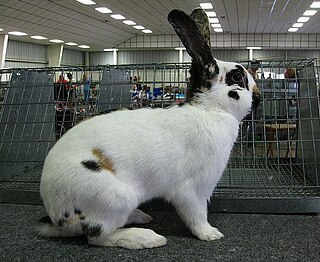
The Rhinelander is a medium-sized breed of domestic rabbit that originated in Germany. Rhinelanders are known for their distinctive facial "butterfly markings", a spine marking, colored ears, cheek spots, eye circles and side markings of black with orange or of blue with fawn. The Rhinelander breed is recognized by the British Rabbit Council (BRC) and by the American Rabbit Breeders Association (ARBA).

The Florida White is a relatively small breed rabbit originally produced for the laboratory or smaller meat rabbit. They are all white in color with no other markings, and have Albino red eyes. They are a recognized American Rabbit Breeders Association (ARBA) breed.
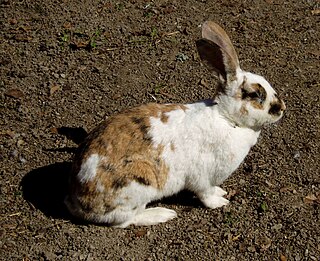
The Gotland rabbit is a Swedish variety of rabbit of medium size that comes in a variety of colours. The Gotland rabbit has official landrace status in Sweden and is considered an endangered variety, but is also being developed as a formal breed under the same name. The landrace is related to the even rarer Mellerud rabbit.

The British primitive goat is a landrace of domestic goat native to Great Britain and Ireland, and is the original goat of the region. It is considered a rare breed, existing as several, isolated feral herds, as some captive populations in zoological parks and nature reserves, and breeding stock on some private farms operated by groups of rare-breed enthusiasts. As few as 1,200 individual British primitives may remain. The variety is also referred to as the British native goat, the old British goat, the old English goat or the British landrace goat, among more specific names It descends from the earliest goats brought to the region in the Neolithic era, around 3,000 BCE. It is classified in the Northern breed group of goats. A population in Northumberland is sometimes referred to as the Cheviot goat. The British primitive is among the foundation stock of some modern standardised breeds, including the Anglo-Nubian goat. The breed is comparatively small, with commensurately low milk production. It is hardy and wiry haired, adapted to rough terrain and weather, and able to subsist and breed on its own without human intervention.

Danish landrace goose, or Danish goose, is a landrace variety of goose native to Denmark.